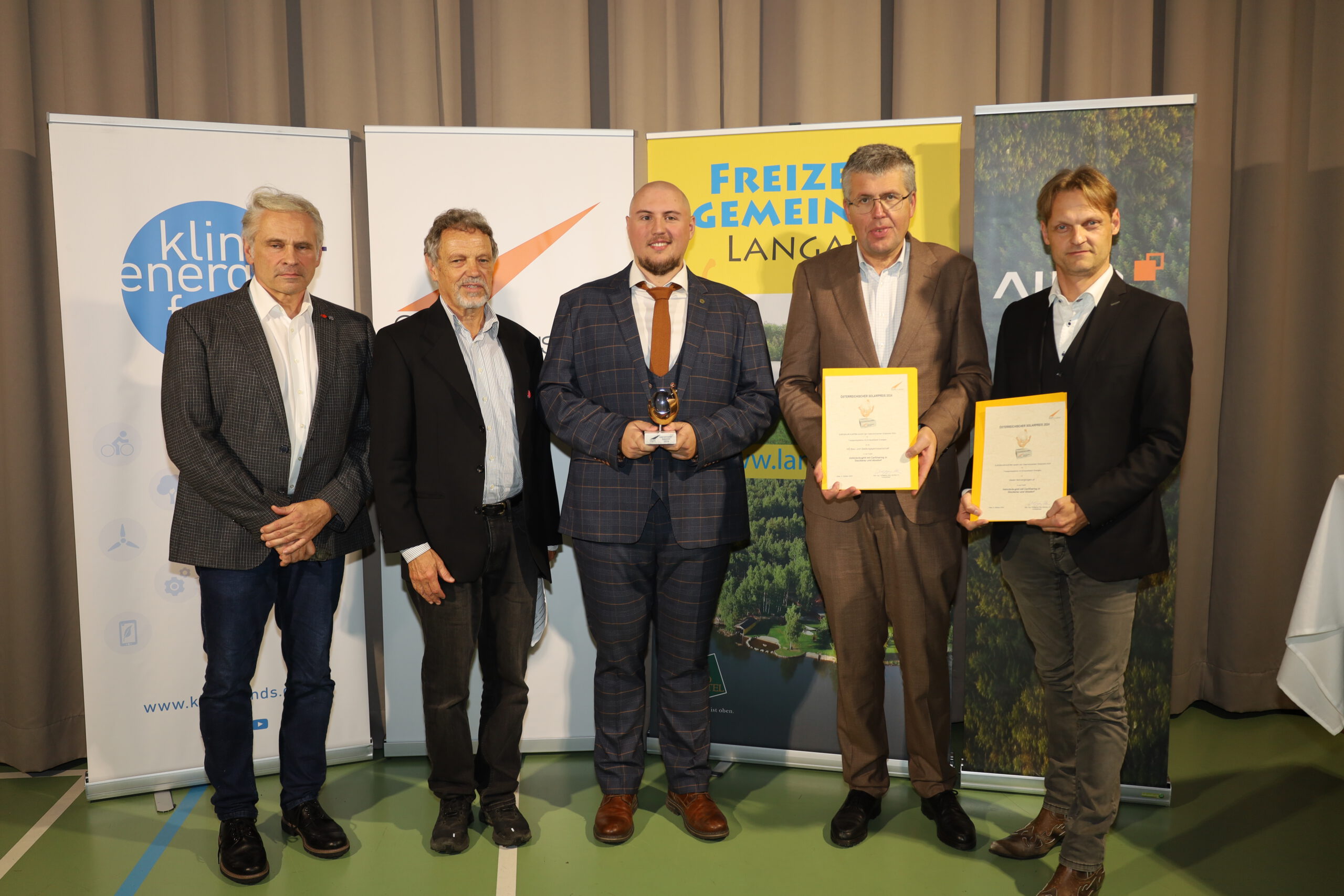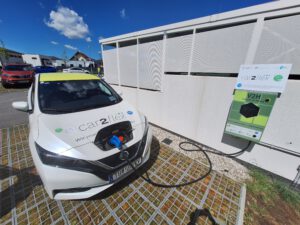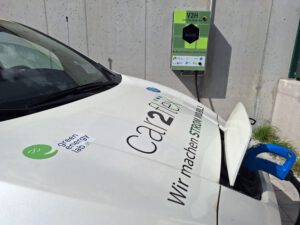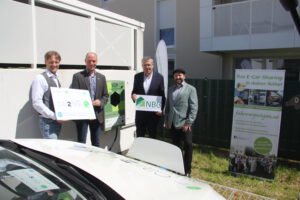Award for bidirectional charging of electric cars
First bidirectional charging stations in car sharing use from fahrvergnügen.at honoured with “Österreichischer Solarpreis“: The pilot application at two locations in Lower Austria is part of the “Car2Flex“ research project from Green Energy Lab.

(from right) Matthias Zawichowski, fahrvergnügen.at; Martin Schuster, NÖ Bau- und Siedlungsgenossenschaft; Florian Fattinger, im-plan-tat Raumplanungs GmbH & CoKG; Wolfgang Hein and Karl Trettler, Eurosolar Austria, at the presentation of Österreichischer Solarpreis. © Eurosolar Austria
Vienna, 09.10.2024 – As part of the “Car2Flex“ research project, an Austria-wide pilot application for the bidirectional operation of electric vehicles in conjunction with car sharing has been realised. Bidirectional – this means that the vehicle battery is not only charged with electricity, but can also feed it back into the grid if required. The application was honoured on 5 October 2024 by being awarded the Österreichischer Solarpreis (Austrian Solar Prize) in the category of transport systems with renewable energies.
“We congratulate all partners of the ‘Car2Flex‘ project on this well-deserved award. Bidirectional charging allows electric cars to be used as buffer storage. This can enable the further expansion of renewable energy production, support the integration of electromobility into the energy system and stabilise the power grid at the same time,“ says Andrea Edelmann, Chairwoman of the Green Energy Lab research initiative.
The mobility association fahrvergnügen.at combines its car sharing service with an application as an electricity storage system for multi-party apartment blocks. Specifically, members have access to e-cars with a 40 kWh battery. The vehicles are reserved via a booking platform. When the cars are not in use, they are parked in front of a residential complex belonging to NÖ Bau- und Siedlungsgenossenschaft (Lower Austrian building and housing co-operative) in Stockerau or Niederösterreichisches Siedlungswerk (Lower Austrian Settlement Organisation) in Absdorf. There, the vehicles are connected to a specially developed bidirectional charging station.
During the day, the electric cars are charged using the on-site photovoltaic system on the roof of the apartment blocks. Depending on the booking situation, the vehicle battery is also available as “mobile storage” for the power supply of the residential complex, for example for lighting the stairwell or operating the lift system. An intelligent control system ensures that at least 40% of the charge level is always available for spontaneous journeys. For better planning, there are also financial incentives for early vehicle bookings: up to six hours before the planned start of the journey, use costs only EUR 7.50 per hour (instead of EUR 9.90). This simplifies the energy management of the vehicle battery and shows how user behaviour can be positively influenced by incentive systems.
“We are delighted to receive this award and to have our pioneering work recognised in this way. In particular, because we see this as confirmation that the networked thinking of mobility services and power supply will be of central importance in the future,“ says Matthias Zawichowski, Chairman of the mobility association fahrvergnügen.at.
Bidirectional charging – how “Car2Flex“ works
The “Car2Flex“ project demonstrates how electric vehicles can be optimally integrated into the energy system by intelligently utilising the capacity of the traction batteries. Thanks to the innovative charging station, electric vehicles can be both charged and discharged, for example to serve as buffer storage for households with PV systems or even to reduce the load on the power grid. This means that electric cars can be charged with surplus electricity from photovoltaics (PV) during the day and feed electricity back into the grid in the evening. Users can use the Car2Flex app to define the extent to which their battery is available as a grid-supporting power storage unit. For fleets and car-sharing vehicles, this can be determined by the operator.

Car sharing car from fahrvergnügen.at at a bidirectional charging station
of the Car2Flex project from Green Energy Lab. © Green Energy Lab
Electric cars could store up to 200 GWh of electricity
There are over 5 million cars in Austria. If all of them were equipped with a battery of 40 kWh (kilowatt hours), this would result in a total storage capacity of 200 GWh (gigawatt hours) – that is more than the national electricity consumption of an entire day. By charging electricity when there is an energy surplus and feeding it back into the grid when there is an increased demand for electricity, the vehicles can significantly reduce the overall load on the system. In this way, they also support the further expansion of renewable energy production, such as solar and wind power, which are very volatile due to changing conditions. These fluctuations in power generation could be balanced out by the widespread use of bidirectional charging and the utilisation of traction batteries as buffer storage. This would also benefit all electricity customers, as it would reduce the costs of stabilising grid interventions. In 2023 alone, these cost electricity customers 141.6 million euros.
“Sometimes we have too little electricity generation throughout the day to cover momentary peaks in consumption. This results in short-term bottlenecks on the consumer side. In future, we will then be able to use the electricity from the vehicle batteries to compensate for the lack of electricity in the grid and won’t need to commission large fossil power plants,“ says Georg Lettner, Car2Flex project manager.

Car sharing car from fahrvergnügen.at at a bidirectional charging station
of the Car2Flex project from Green Energy Lab. © Green Energy Lab
Field trial in Lower Austria continues successfully
The bidirectional charging stations are operated exclusively for two electric car sharing cars at the Stockerau (Gustav Mahler-Promenade) and Absdorf (Wiesenstraße 1) locations. The apartment blocks each have a PV system on the roof with a maximum output of 8 and 10 kWp respectively. The housing developers involved in the project, NÖ Bau- und Siedlungsgenossenschaft (NBG) and Niederösterreichische Siedlungswerk Gemeinnützige Gesellschaft (NÖSW), want to provide affordable mobility in conjunction with pioneering technologies. This mobility service is operated by the mobility association “fahrvergnügen.at“ in cooperation with the technical office im-plan-tat. It is supported – alongside a large number of regional partners – by Energie- und Umweltagentur des Landes Niederösterreich.
The “Car2Flex“ project is being carried out as part of the Green Energy Lab research initiative and is funded by the Climate and Energy Fund as part of the “Vorzeigeregion Energie“ programme. Project partners include the technology companies Schrack and Fronius as well as the energy supply companies EVN, Burgenland Energie and Energie Steiermark.

Opening of the first bidirectional charging station in Stockerau: (from left) Matthias
Zawichowski, Verein fahrvergnügen.at / im-plan-tat Raumplanungs GmbH & CoKG;
Matthias Komarek, Energie- und Umweltagentur des Landes Niederösterreich; Martin
Schuster, NÖ Bau und Siedlungsgenossenschaft; Ludwig Fliesser, Forschungsinitiative
Green Energy Lab. © Raumplanungsbüro im-plan-tat
The Car2Flex research project
As part of the Green Energy Lab research initiative, the Car2Flex lead project is looking at bidirectional charging and three different user groups of electric mobility: private users, e-vehicle fleets and e-car sharing in multi-party apartment blocks. The focus is on the question of how – in line with the mobility needs of the respective groups – the increasing share of e-mobility can be ideally integrated into the energy system. With bidirectional charging stations, it is not only possible to charge electricity into the traction batteries, but also to draw power from them again. This means that the car can be used as an intermediate storage unit for private households with PV systems, for example. If the capacities of large e-fleets are bundled, this could also serve to stabilise the power grid. This is explained in the following video:
You are currently seeing a placeholder content of YouTube. To access the actual content, click on the button below. Please note that data will be passed on to third-party providers.
The Car2Flex project, led by Technische Universität Wien (Energy Economics Group), is funded by the Climate and Energy Fund and implemented as part of the RTI initiative Flagship Region Energy Green Energy Lab. The project partners are AED Systems KG, AIT Austrian Institute of Technology, Burgenland Energie AG, ecoplus. Niederösterreichs Wirtschaftsagentur GmbH, Energie Steiermark AG, EVN AG, Fachhochschule Technikum Wien, Forschung Burgenland, Fronius International, Grazer Energieagentur, im-plan-tat Raumplanungs GmbH & Co KG, JOANNEUM RESEARCH Forschungsgesellschaft, Montanuniversität Leoben, Energie- und Umweltagentur des Landes NÖ, Reisenbauer Solutions GmbH, Salzburg Netz, Schrack Technik GmbH, SPECTRA TODAY GMBH, Stromnetz Graz GmbH & Co KG, Verein fahrvergnügen.at
Contact
Ludwig Fliesser
Communications Manager
T: +43 676 471 93 47
E: ludwig.fliesser@greenenergylab.at
